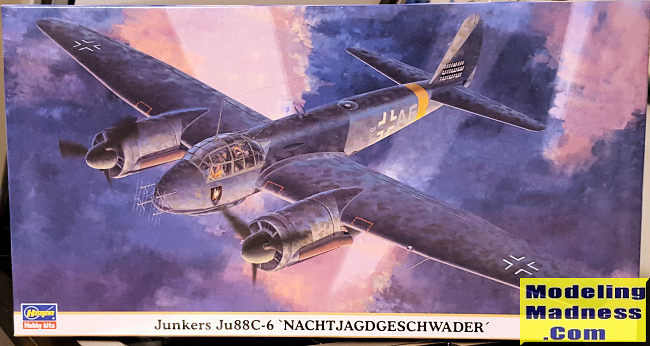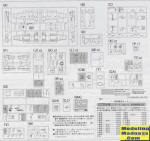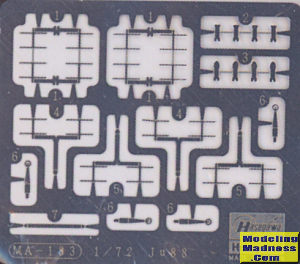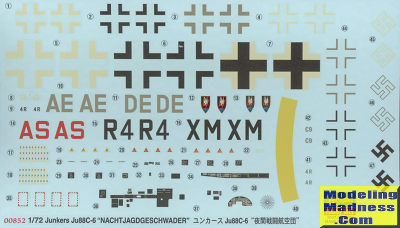
| KIT #: | 00852 |
| PRICE: | 3400 yen SRP |
| DECALS: | Four options |
| REVIEWER: | Scott Van Aken |
| NOTES: | 2007 Limited Edition. Includes etched fret |

| HISTORY |
The Ju 88C was originally intended as a fighter-bomber and heavy fighter by adding fixed, forward-firing guns to the nose while retaining some bomb carrying ability of the A-series bomber. The C-series had a solid metal nose, typically housing one 20 mm MG FF cannon and three 7.92 mm (.312 in) MG 17 machine guns. The aircraft retained the ventral Bola gondola under the crew compartment though individual units sometimes removed this to reduce weight and drag to enhance performance. The Ju-88C was later used as a night fighter, and this became its main role.
The first version of the Ju 88C was the C-1 with 20 aircraft converted from A-1 airframes. Some of them entered service in the Zerstörerstaffel of KG 30 which became part of II./NJG 1 in July 1940. The C-1 was followed by the C-2 of which 20 aircraft were converted from A-5 airframes with enlarged wingspan. The C-4 became the first production version with 60 produced and 60 converted from A-5 airframes. The C-6, of which 900 aircraft were produced, was based on the A-4 airframe with more powerful engines and stronger defensive armament (single- or dual-mount belt-fed 7.92 mm MG 81 or 13 mm MG 131 instead of drum-fed MG 15 machine guns).The C-6 as night fighter was typically equipped with FuG 202 Lichtenstein BC low-UHF band airborne intercept radar, using the complex 32-dipole Matratze antennas. The first four C-6 night fighters were tested in early 1942 by NJG 2. The trials were successful and the aircraft was ordered into production. In October 1943, many C-6s were upgraded with new radar systems. The first new radar equipment was the FuG 212 Lichtenstein C-1. After the UHF-band Lichtenstein radars had been compromised to the Allies in the late spring of 1943, the next development in German AI radar was the VHF-band FuG 220 Lichtenstein SN-2, discarding the 32-dipole Matratze antennae for the much larger eight-dipole Hirschgeweih (stag's antlers) aerials, required for the longer wavelength SN-2 system.
Many Ju-88C's had their Bola gondolas modified to hold up to two forward firing 20 mm cannons. Several C-6 night fighters were equipped with two "Schräge-Musik" upward-firing 20mm cannons in trial fittings, and from mid 1943 onward, there was an official field modification kit available for this arrangement.
A small number of the C-series day fighters had their new solid-metal noses specially painted to resemble the bomber A-series' "beetle's eye" faceted clear view nose glazing, in an attempt to deceive Allied pilots into thinking the fighters were actually bombers; the unusual "camouflage" attempt did result initially in a number of Allied aerial losses.
| THE KIT |
 Any
more, a major kit manufacturer will not expend the resources on a kit unless
they can do multiple variants. The Ju-88 is a perfect subject for this as it was
done in multiple variants, each of which was used by a large number of units.
This allows for a large number of Limited Editions based on the Ju-88A-4 basic
boxing. Hasegawa has done a good job of following this and so you have a kit
that has a lot of subassemblies and inserts. While I wish they'd do an A-5 or
A-1 variant, that requires different wings so Hasegawa has not gone that route
yet. Too bad as those variants were the most used in the early war and the
Battle of Britain.
Any
more, a major kit manufacturer will not expend the resources on a kit unless
they can do multiple variants. The Ju-88 is a perfect subject for this as it was
done in multiple variants, each of which was used by a large number of units.
This allows for a large number of Limited Editions based on the Ju-88A-4 basic
boxing. Hasegawa has done a good job of following this and so you have a kit
that has a lot of subassemblies and inserts. While I wish they'd do an A-5 or
A-1 variant, that requires different wings so Hasegawa has not gone that route
yet. Too bad as those variants were the most used in the early war and the
Battle of Britain.
 This is the
C-6 version with the solid nose and a few other differences, but as mentioned,
it is basically very much like the basic boxing A-4. There are four markings
options provided and you have two different radar antenna options. One is the
multiple dipole variant which is provided mostly on the photo etch fret that is
included. You also get the SN-2 antennas. In addition, you can have the upper
firing 20mm guns. This means that there will be holes to open so you need to be
pretty well set on the markings option you want to use right from the start.
Other options you have are for the rear firing gun (or lack of one) in the lower
gondola and the calibre of the single upper rear firing weapon.
This is the
C-6 version with the solid nose and a few other differences, but as mentioned,
it is basically very much like the basic boxing A-4. There are four markings
options provided and you have two different radar antenna options. One is the
multiple dipole variant which is provided mostly on the photo etch fret that is
included. You also get the SN-2 antennas. In addition, you can have the upper
firing 20mm guns. This means that there will be holes to open so you need to be
pretty well set on the markings option you want to use right from the start.
Other options you have are for the rear firing gun (or lack of one) in the lower
gondola and the calibre of the single upper rear firing weapon.
I've built a couple of Hasegawa Ju-88s and while they do have a goodly number of inserts, they are fairly straight-forward builds. I expect the p.e. antennas to be the biggest hurdle for this kit.
 Instructions
are well done with the usual Gunze paint references. The first two options are
are painted like the box art aircraft. Note that this plane has the two shrage
musik cannon fore and aft. The rest have them side by side. The third option has
both the smaller and the large radar antenna. This and the next plane are in an
overall RLM 76 with mottles of various sizes. The final option has only the
larger SN-2 radar antenna. Decals are nicely printed, but are old school
Hasegawa decals that will be a bit thick and where the whites are an off white
shade. You may want to replace any of the insignia that have white in them.
There are also aftermarket sheets, but the kit options give you a goodly number
of choices.
Instructions
are well done with the usual Gunze paint references. The first two options are
are painted like the box art aircraft. Note that this plane has the two shrage
musik cannon fore and aft. The rest have them side by side. The third option has
both the smaller and the large radar antenna. This and the next plane are in an
overall RLM 76 with mottles of various sizes. The final option has only the
larger SN-2 radar antenna. Decals are nicely printed, but are old school
Hasegawa decals that will be a bit thick and where the whites are an off white
shade. You may want to replace any of the insignia that have white in them.
There are also aftermarket sheets, but the kit options give you a goodly number
of choices.
| CONCLUSIONS |
This is a very good kit and well worth building. Perhaps more expensive than the Zvezda alternative, but in my book the first choice. Italeri also makes a fairly good Ju-88, but from what I've built of them, doesn't have the greatest fit.
| REFERENCES |
https://en.wikipedia.org/wiki/Junkers_Ju_88#Ju_88C_2
February 2020
Copyright ModelingMadness.com.All rights reserved
If you would like your product reviewed fairly and fairly quickly, please
contact
the editor or see other details in the
Note to
Contributors. Back to the Main Page
Back to the Review
Index Page
Back to the Previews Index Page